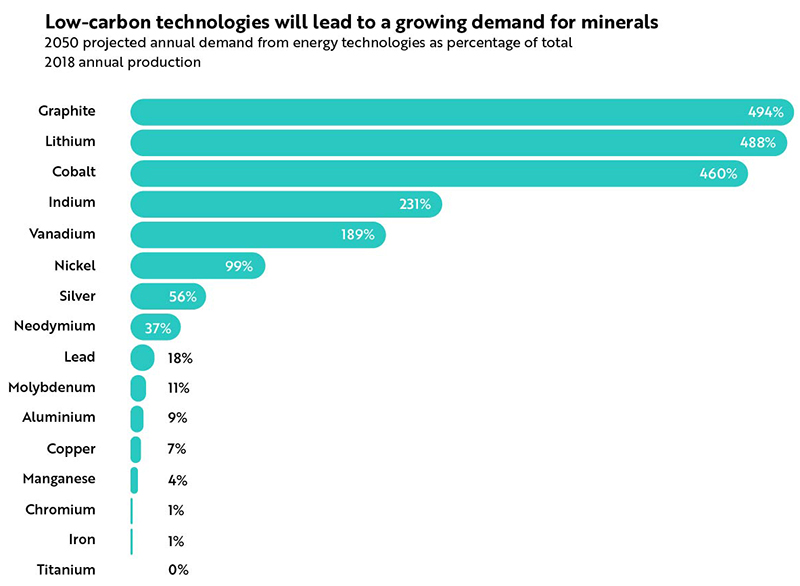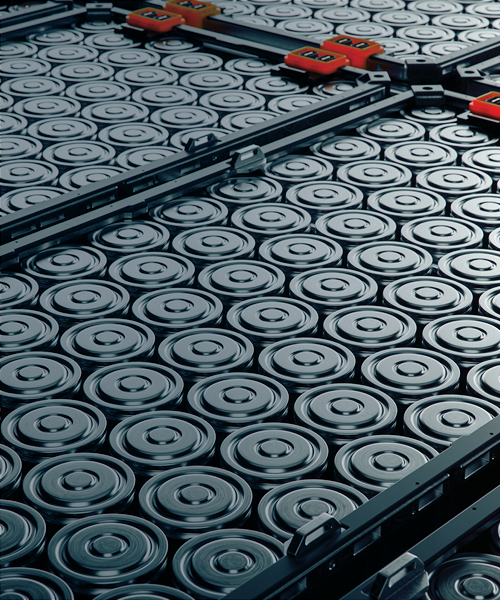June 22, 2021 • 4 min read
Battery supply chains: How to make them faster and more sustainable
The world needs more batteries. The challenge is to establish battery materials supply chains at the scale required to reach mid-century decarbonization targets
Passenger electric vehicles (EVs) are responsible for much of the demand growth for batteries. According to GlobalData, production of EVs will reach 12.7 million units in 2024. With each EV battery weighing around 200 kilograms, expanding supply is going to take a lot more minerals and metals.
The World Bank projects high demand for new energy materials, as shown in the graph below. Many of these materials are the key components for batteries, with the materials for EV batteries seeing the highest demand.
How can we ensure battery supply chains keep pace with demand?

Overhauling the traditional approach to project delivery
According to Mervyn Stevens, Vice President, Mineral Processing and Battery Materials, “miners need to find ways to get these materials to market faster than other commodities.
This means they can no longer follow traditional development cycles, which tend to follow sequential processes and take longer move into production.
It also leaves them with a new set of challenges.
“Securing enough raw materials to meet demand is the first challenge,” he says. “There is a looming supply deficit across the materials needed to make batteries such as lithium, nickel and cobalt. While for battery manufacturers, securing the right purity is an equally pressing issue.
“For all companies involved in the batteries supply chain, setting up sustainable practices to deliver batteries with a lower carbon footprint will need to be considered at every step.”
The industry risks moving the commercial viability of batteries in the wrong direction as prices surge and supply timing slips.
Creating a new mining supply chain
Mining and production generally act independently. Raw battery materials are often produced by traditional mining companies. But the purification and processing, especially on the cathode side, is produced by fine chemicals companies.
However, the pressure to deliver battery materials and the final technology quickly is forging new alliances across the supply chain. Miners are beginning to look downstream to partnerships with battery component producers. And battery cell manufacturers are partnering with miners to get closer to the source.
“EV manufacturers are now securing long-term, billion-dollar deals with battery manufacturers to prepare. These and other companies that rely on battery technology are moving upstream in the supply chain to preserve a steady flow of quality materials to build their products,” explains Stevens. “And in this case, quality is key.”
Maintaining purity with lower quality materials
Battery manufacturers need these raw materials to be at a high purity.
“Quality materials help alleviate safety hazards associated with poor quality batteries and to meet rigorous product specifications,” says Stevens. “But conversions and steps to purify even high quality raw materials add time and cost to the supply chain. It also requires an understanding of the complex metallurgical and chemical processes involved.”
Lower quality material can be purified, too. For example, ion exchange or acid wash for metals and caustic processes for graphite. Lower purity sulphates, sometimes a by-product from other producers, are more easily accessible and have different applications in the market.
“It’s a lot quicker than having to mine a new deposit or reach a higher quality reserve,” says Stevens. “It can also deliver significantly better return on investment, keep costs contained and improve productivity.”
By adding a purification step to low quality materials, manufacturers can elevate these into battery-grade or precursor materials that meet the strict product specifications required.
“This is new ground, as we bridge the traditional mining and minerals industries with complex chemicals processing under pharmaceutical-like production specifications, and scale them to meet demand.”
Improving circularity and sustainability performance
Even if we deliver high grade material in the shortest amount of time, demand from the EV battery market will likely be met through circular economy principles.
“As recycling technology progresses and the volume of end-of-life battery material grows, manufacturers should be exploring partnerships to help them develop batteries with a lower carbon footprint,” says Stevens. “This includes integrating cell manufacturing with module packing and using recycling to close the loop and create a circular economy.”
When done right, this can also lead to overall optimization of plant efficiency. As an example, Stevens points to a full scale cathode facility that raised the water recycle rate from 40 percent to 95 percent while maintaining product quality and lowering operating costs and environmental impact.
Using renewables for electricity supply and transitioning to EVs is also part of the solution. It allows input materials to carry a smaller CO2 footprint all the way through to the battery manufacturing phase.
From the mine to battery components
Partnerships, joint ventures, and collaborations across the entire battery supply chain will be key when it comes to meeting the demand for batteries in a sustainable way.
“Our position in both chemicals and mining allows us to support delivery across the supply chain,” says Stevens. “We can start right at the mine site, having completed more than 200 projects that involve mining graphite, nickel, manganese, vanadium, lithium and cobalt.
“We see this through the intermediate processing steps by helping our customers refine and convert raw materials into active material, which are the final key ingredients needed to make batteries. This includes graphite anode facilities from mining through to anode precursor, and we’ve completed work for several cathode precursor producers of Li-ion NCM material and electrolyte.
“The energy transition is a journey,” he continues. “And if the industry can collaborate like never before, we can deliver sustainable batteries at scale, originating from environmentally sustainable mines.”






